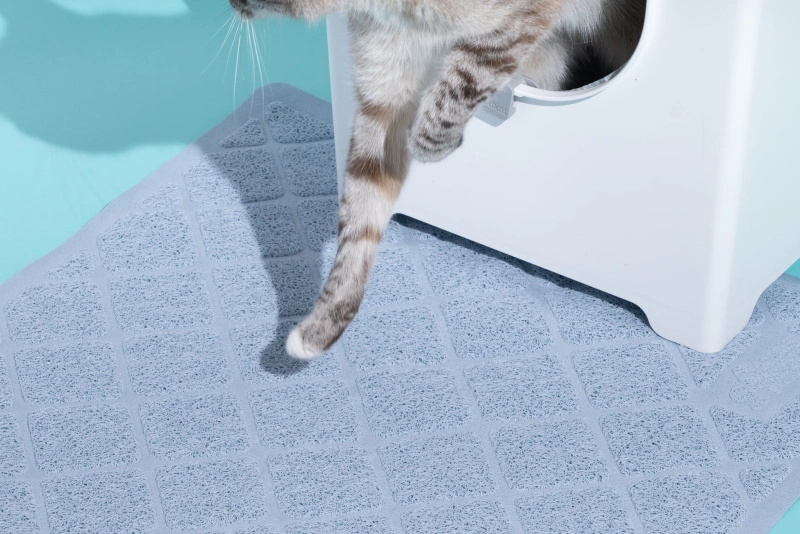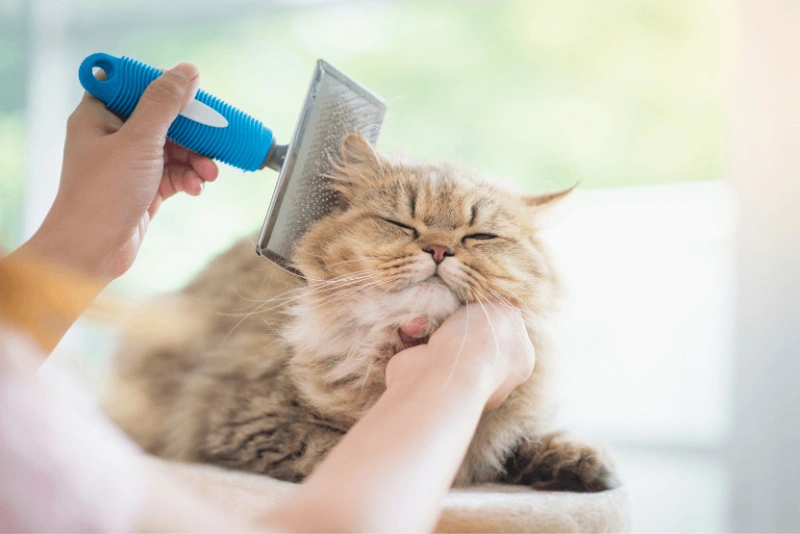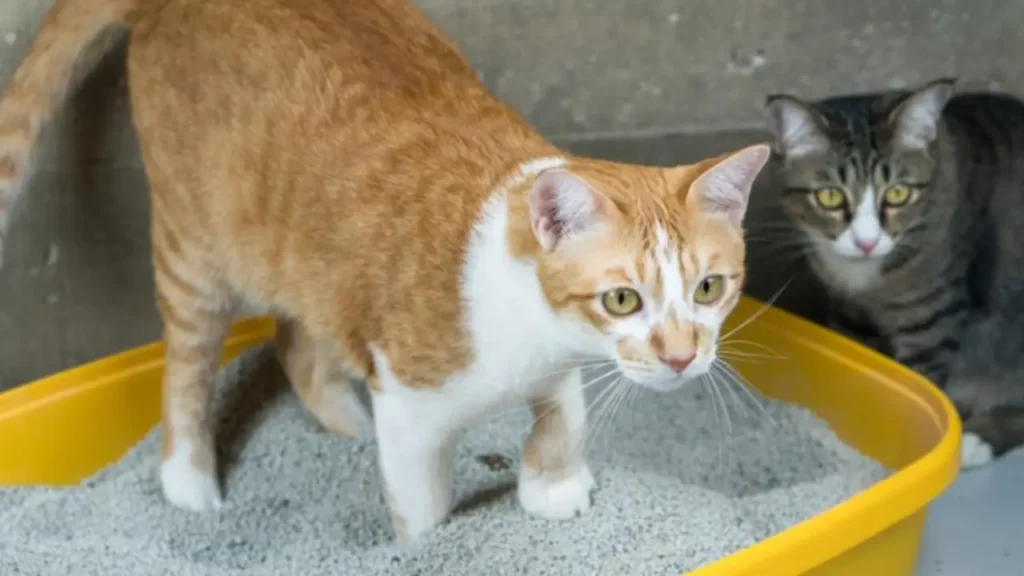Are you constantly battling the never-ending trail of cat litter scattered around your home? If so, you’re not alone! Many cat owners face this messy dilemma. In “How To Stop Cat Litter Tracking: The Ultimate Guide,” we’ll explore effective strategies and products designed to minimize litter mess and keep your living space tidy.
Say goodbye to those pesky litter bits and hello to a cleaner home! Ready to reclaim your floors? Let’s dive into the ultimate tips on how to stop cat litter tracking today!
What Is Cat Litter Tracking?

Cat litter tracking refers to the phenomenon where cat litter is scattered around the house, often due to cats’ paws carrying litter particles outside the litter box. This can be a common problem for cat owners, leading to a messy and unhygienic environment.
Tracking can be caused by various factors, including the type of litter, the size and placement of the litter box, and the cat’s behavior.
Why Does My Cat Track Litter Everywhere?

Why is my cat tracking litter?
Cat litter tracking can be a common problem, but understanding the underlying reasons can help you address the issue more effectively. Here are some common factors that contribute to litter tracking:
- Paw Pad Hygiene: Cats’ paws are naturally clean, but they can pick up litter particles as they move around the litter box.
- Litter Box Size and Location: If the litter box is too small or located in a high-traffic area, cats may be more likely to jump in and out quickly, spreading litter.
- Litter Type: Some litter types are more prone to cracking than others, such as lightweight or powdery litters.
- Cat Behavior: Playful cats, or those with anxiety or other behavioral issues, may be more likely to dig and scatter litter.
By addressing these potential causes, you can take steps to minimize litter tracking and create a cleaner home for both you and your cat.
Why Is It Essential To Prevent Litter Tracking?
Preventing litter tracking is essential for several reasons:
- Hygiene and Health: Tracked litter can spread bacteria and parasites, potentially affecting both your cat’s health and your own.
- Home Aesthetics: Litter tracking can make your home look messy and unkempt, detracting from its overall appearance.
- Reduced Stress: Dealing with litter tracking can be time-consuming and frustrating, leading to increased stress.
- Pet Comfort: A clean and litter-free environment can contribute to your cat’s overall comfort and well-being.
By taking steps to prevent litter tracking, you can create a healthier, more pleasant living space for both you and your feline companion.
9 Tips about How To Stop Cat Litter Tracking

Tips 1: Choose No-Track Litter
Struggling with cat litter tracking? One effective solution is to choose no-track litter. This type of litter is designed to minimize mess, making cleanup easier. Look for options like pellet litter, which reduces tracking significantly due to its larger size and weight.
Low-dust formulas are also a great choice, as they help keep your home cleaner and healthier for both you and your cat. By using these types of cat litter, you’ll see less litter scattered around your space.
Tips 2: Choose Suitable Litter Box

Choose a litter box is helpful for containing the mess. Look for a litter box with high sides to prevent litter from being kicked out. A covered litter box can also be a great option, as it helps to trap in odors and litter. For a medium-sized cat, a litter box that’s approximately 15 inches long, 12 inches wide, and 18 inches high should be sufficient.
Tips 3: Where To Put Your Litter Box
Once you’ve got the perfect litter box, it’s time to find the perfect spot. Cats like privacy and quiet, so try to place the litter box in a calm, secluded area. Avoid placing it near loud noises or high-traffic areas. A quiet corner in the bathroom or laundry room is often a good choice. Remember, consistency is key. Keep the litter box in the same place to avoid confusing your cat.
Tips 4: Use An Anti-Tracking Mat

A litter box mat is an essential tool in the fight against litter tracking. These mats are designed to trap litter on their surface, preventing it from being carried throughout your home. They’re especially useful for cats that tend to shake their paws after using the litter box.
Look for a mat with a textured surface that can effectively grab litter particles. A rubber or silicone mat is a good option, as they’re durable and easy to clean.You also can Place the Litter Box on a Carpet-Free Floor.
Tips 5: Daily Litter Cleaning

Daily litter cleaning is key to preventing litter tracking. A clean litter box encourages your cat to use it regularly and helps to reduce odors that might deter them. Keep a broom and dustpan nearby for quick cleanups, and vacuum regularly to remove any litter that has made its way onto carpets or other surfaces.
For even more convenience, consider keeping a cordless vacuum by the litter box. This way, you can quickly clean up any spills or messes without having to lug around a larger vacuum.
Tips 6: Liners Simplify Litter Box Changes
Liners can make litter box changes a breeze. Not only do they simplify the cleaning process, but they also help to contain messes and prevent litter from sticking to the bottom of the litter box. Look for biodegradable liners that are safe for your cat and the environment.
Some popular options include newspaper, recycled paper, and corn-based liners. Experiment with different types to find the one that works best for you and your cat.
Tips 7: Trimming Long-Haired Cats

Long-haired cats can be prone to litter tracking due to their fur. Regular grooming can help to reduce the amount of litter that gets stuck to their fur. Brush your cat daily to remove loose hair and prevent mats from forming.
Consider trimming the hair around their paws and tail, as these areas can be particularly prone to litter tracking. If you’re unsure about how to groom your cat yourself, consider taking them to a professional groomer.
Tips 8: Control The Amount Of Cat Litter
Using the right amount of litter is crucial for preventing tracking. Too much litter can encourage cats to dig and kick, while too little can leave them uncomfortable. A good rule of thumb is to fill the litter box to a depth of about two to three inches. Monitor your cat’s habits and adjust the litter depth as needed.
Tips 9: Choose QUICK-CLUMPING Cat Litter
Quick-clumping litter is a game-changer when it comes to litter tracking. This type of litter forms tight clumps when it comes into contact with liquid, making it easy to scoop and dispose of. This reduces the amount of litter that gets stuck to your cat’s paws and helps to keep your home clean.
Plus, quick-clumping litter often controls odors better than traditional clay litter, making for a more pleasant environment for both you and your feline friend.


How to Avoid Cat Litter Tracking

Preventing cat litter tracking requires a combination of strategies. Here are some effective tips to keep your floors clean and your cat happy:
Litter Box Maintenance
- Cleanliness: Regularly scoop out soiled litter and clean the litter box with mild soap and water.
- Size and Location: Ensure the litter box is large enough for your cat to comfortably move around and avoid feeling cramped. Place it in a quiet, low-traffic area away from food and water sources.
- Litter Type: Experiment with different litter types to find one that minimizes tracking. Consider using clumping litter or larger-grained options.
Cat Grooming
- Paw Care: Gently wipe your cat’s paws with a damp cloth or baby wipes after they use the litter box to remove any clinging litter particles.
- Coat Care: Regularly brush your cat to remove excess fur that can carry litter.
Environmental Changes
- Litter Mat: Place a litter mat outside the litter box to catch any litter that falls off your cat’s paws.
- Floor Covering: Consider using rugs or mats in areas around the litter box to absorb tracked litter.
- Training: If your cat is digging excessively in the litter box, try providing a scratching post or other interactive toys to divert their attention.
Additional Tips
- Multiple Litter Boxes: For multi-cat households, provide at least one litter box per cat plus one extra.
- Veterinary Check-Up: If your cat is suddenly experiencing increased litter tracking, rule out any underlying health issues by consulting with your veterinarian.
By implementing these strategies, you can significantly reduce cat litter tracking and create a cleaner, more enjoyable living environment for both you and your feline friend.
How to Reduce Cat Litter Tracking
Cat litter tracking can be a frustrating problem for pet owners. Here’s a detailed guide to help you minimize it:
Litter Box Maintenance
- Cleanliness: Scoop out the soiled litter daily and clean the litter box thoroughly at least once a week with mild soap and water.
- Size and Location: Ensure the litter box is large enough for your cat to comfortably move around. Place it in a quiet, low-traffic area away from food and water sources.
- Litter Type: Experiment with different litter types to find one that minimizes tracking. Clumping litter and larger-grained options often work well.
Cat Grooming
- Paw Care: Gently wipe your cat’s paws with a damp cloth or baby wipes after they use the litter box to remove any clinging litter particles.
- Coat Care: Regularly brush your cat to remove excess fur that can carry litter.
Environmental Changes
- Litter Mat: Place a litter mat outside the litter box to catch any litter that falls off your cat’s paws.
- Floor Covering: Consider using rugs or mats in areas around the litter box to absorb tracked litter.
- Training: If your cat is digging excessively in the litter box, try providing a scratching post or other interactive toys to divert their attention.
Additional Tips
- Multiple Litter Boxes: For multi-cat households, provide at least one litter box per cat plus one extra.
- Veterinary Check-Up: If your cat is suddenly experiencing increased litter tracking, rule out any underlying health issues by consulting with your veterinarian.
By following these steps, you can significantly reduce cat litter tracking and create a cleaner, more enjoyable living environment for both you and your feline friend.
Solutions for Cat Litter Tracking
Cat litter tracking can be a frustrating problem for pet owners. Here are some effective solutions to help keep your home clean:
Litter Box Maintenance
- Regular cleaning: Scoop out soiled litter daily and clean the litter box thoroughly at least once a week with mild soap and water.
- Proper sizing: Ensure the litter box is large enough for your cat to comfortably move around.
- Optimal placement: Place the litter box in a quiet, low-traffic area away from food and water sources.
- Litter type: Experiment with different litter types to find one that minimizes tracking. Clumping litter and larger-grained options often work well.
Cat Grooming
- Paw care: Gently wipe your cat’s paws with a damp cloth or baby wipes after they use the litter box to remove any clinging litter particles.
- Coat care: Regularly brush your cat to remove excess fur that can carry litter.
Environmental Changes
- Litter mat: Place a litter mat outside the litter box to catch any litter that falls off your cat’s paws.
- Floor covering: Consider using rugs or mats in areas around the litter box to absorb tracked litter.
- Training: If your cat is digging excessively in the litter box, try providing a scratching post or other interactive toys to divert their attention.
Additional Tips
- Multiple litter boxes: For multi-cat households, provide at least one litter box per cat plus one extra.
- Veterinary check-up: If your cat is suddenly experiencing increased litter tracking, rule out any underlying health issues by consulting with your veterinarian.
By implementing these solutions, you can significantly reduce cat litter tracking and create a cleaner, more enjoyable living environment for both you and your feline friend.
Clumping Cat Litter That Doesn’t Track
Clumping cat litter is a popular choice among pet owners due to its ability to form clumps around waste, making it easier to clean. However, not all clumping litters are created equal when it comes to tracking. Here are some factors to consider when choosing a clumping litter that minimizes tracking:
Grain Size
- Larger grains: Generally, larger-grained clumping litters are less likely to track. The larger particles are less likely to stick to your cat’s paws.
Texture
- Smooth texture: A smooth texture can help prevent litter from clinging to your cat’s fur.
Clumping Strength
- Strong clumping: A strong clumping ability ensures that waste is effectively contained, reducing the likelihood of litter being scattered.
Dust Content
- Low dust: Litters with low dust content are less likely to be tracked, as dust particles can easily adhere to your cat’s paws and fur.
Popular Clumping Litter Brands
- Tidy Cats: Known for its lightweight and low-tracking properties.
- Fresh Step: Offers a variety of clumping litters with different scents and formulas.
- Arm & Hammer: Known for its odor-control capabilities and low-tracking features.
Note: While these factors can help reduce tracking, it’s important to remember that individual cat behaviors and litter box maintenance also play a significant role. Experiment with different brands and types of clumping litter to find the best option for your cat and your home.
Conclusion
Cat litter tracking can be a frustrating problem, but with the right strategies, it can be effectively managed. By following the tips and recommendations outlined in this blog post, you can create a cleaner home environment and minimize the hassle of litter cleanup. Remember to experiment with different litter types, maintain your litter boxes regularly, and pay attention to your cat’s grooming needs.
Are you a business owner looking for a custom cat litter solution that addresses your specific needs? Contact us today to discuss your requirements and explore how our tailored cat litter products can help you create a cleaner and more hygienic environment for your feline customers.
FAQ
How to minimize cat litter tracking?
To minimize tracking, use a litter mat to catch stray litter, choose a low-tracking litter, and consider a covered litter box. Regularly clean the area around the box and ensure the box is in a quiet, accessible location.
Is there a cat litter that doesn’t track?
Yes, there are several litters designed to minimize tracking. Look for larger granules or clumping litters that tend to stay in the box better, such as crystal or wood-based litters.
What is the best cat litter for no tracking?
Some of the best cat litters for reducing tracking include crystal litter, natural wood pellets, and larger granule clumping litters. Brands specifically marketed as low-tracking can also be effective.
Do litter mats work?
Yes, litter mats are effective in reducing tracking. They are designed to catch litter particles from your cat’s paws and can be easily cleaned to maintain a tidy area around the litter box.
How often should I change my cat’s litter?
Ideally, you should completely change your cat’s litter every 1-2 weeks. However, scooping daily and maintaining a clean box can help extend the freshness between full changes.
What is litter box avoidance?
Litter box avoidance occurs when a cat refuses to use the litter box, often due to stress, health issues, or an unclean box. It’s essential to identify the cause and address it promptly.
Why do vets not recommend closed litter boxes?
Vets may advise against closed litter boxes because they can trap odors and reduce airflow, leading to discomfort for the cat. Additionally, some cats may feel claustrophobic or stressed in a closed environment.
What can I use instead of a litter mat?
If you don’t have a litter mat, consider using an old towel or rug that can catch litter. Some people also use rubberized flooring or even a large piece of cardboard under the litter box for easy cleanup.
Do cats like when you clean their litter box?
While cats don’t have strong feelings about the act of cleaning, they do prefer a clean space to do their business. Regular cleaning can help keep them comfortable and willing to use the box.
Where not to put a litter box?
Avoid placing the litter box in high-traffic areas, near the cat’s food and water bowls, or in loud or chaotic environments. Cats prefer quiet, private spaces to feel secure while using the box.











